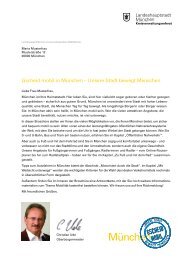D2.1 Stakeholder Involvement Handbook - AENEAS
D2.1 Stakeholder Involvement Handbook - AENEAS
D2.1 Stakeholder Involvement Handbook - AENEAS
Create successful ePaper yourself
Turn your PDF publications into a flip-book with our unique Google optimized e-Paper software.
<strong>D2.1</strong> <strong>Stakeholder</strong> <strong>Involvement</strong> <strong>Handbook</strong><br />
1 Introduction<br />
The <strong>AENEAS</strong> project's objective is to become a reference project in the field of urban<br />
mobility in ageing societies. Bringing together leading European players in the field of older<br />
people's mobility, <strong>AENEAS</strong> will improve the attractiveness of sustainable transport and will<br />
contribute to modal shifts towards energy-efficient modes of transport among the generation<br />
50+. Most initiatives covering the topic of ageing societies and transport so far had a<br />
research character and rather focused on accessibility and infrastructure. Unlike these<br />
projects, <strong>AENEAS</strong> will develop concrete soft measures to be taken up by other European<br />
cities and municipalities. Providing a broad range of activities, all these local measures will<br />
address one common issue: How can alternatives to the private car fit older people’s<br />
requirements and how can senior citizens be motivated to use them? In <strong>AENEAS</strong>, the cities<br />
of Donostia-San Sebastián, Kraków, Munich, Odense, Salzburg and their supporting<br />
organisations will also implement concrete on-site measures.<br />
However, it has become clear to the partners that due involvement of stakeholders is a key<br />
to success. It needs to be considered that older people are somewhat reluctant towards<br />
classical tools of marketing and awareness raising. They really need to be personally<br />
addressed and involved for behavioural changes to be achieved. On the other hand,<br />
multipliers like older citizens’ associations can help you to break the ice, while other<br />
stakeholders may not be aware of which role they play in older people’s daily mobility.<br />
The MESsAGE project (State of the Art, p.58, 2007) has described the benefits of<br />
stakeholder involvement as follows (and <strong>AENEAS</strong> agrees with this): “From a pragmatic point<br />
of view, the main benefit of citizen participation is that it creates a widespread support, which<br />
increases the acceptance and legitimacy of policy plans. By making citizens responsible for<br />
the achieved results, resistance against incorporated decisions can be avoided. They would<br />
better understand the need for a certain project and perhaps be more willing to accept<br />
compromises. Also, it can reduce the lack of trust in governmental institutes.”<br />
The <strong>AENEAS</strong> <strong>Stakeholder</strong> <strong>Involvement</strong> <strong>Handbook</strong> is intended to encourage organisations<br />
which are not familiar with stakeholder involvement to try out some of the tools and<br />
techniques in their own projects. Since excellent work has been done in this field before, this<br />
document is largely building on these experiences, however focusing on older people and<br />
relevant stakeholders respectively. For further reading, please see the recommendations at<br />
the end of this handbook.<br />
Page 4




